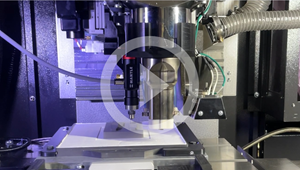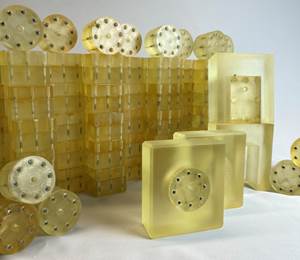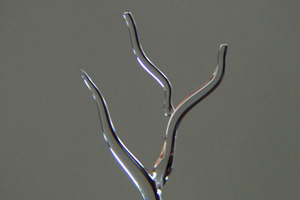SK Industriemodell’s Technology Designed to Accelerate, Improve Development Cycles of Prototypes, Components and Products
Formnext 2024: Technology enables the development of sophisticated components.
Impeller and dissolvable inserts of the 3D printed tool. Source (all images): SK Industriemodell GmbH
SK Industriemodell has developed 3D printed tools and processes to accelerate and improve development cycles of prototypes, components and products. This includes injection molding machines using a 3D printed tool with dissolvable inserts and a “hybrid tooling” process.
The company says the technology enables users to develop prototypes and components faster, better and more effectively. “In the manufacture of series tools as well as prototypes, components and products, companies in numerous industries are faced with the challenge of having to design their approach and processes in research and development as well as in product development faster, better and more effective,” says Sebastian Krell, SK Industriemodell managing director.
At Formnext, the company will be presenting 3D printed tools as well as processes that shorten iteration loops with series material, reducing the need to change the design of a series tool, and enable extremely detailed representations and filigree geometries to be realized within a component.
The company says the basis for this technology is the “Print and Inject” process (freeform injection molding), which combines the best of 3D printing and injection molding with 3D printing injection molds, enabling speed, flexibility and material variety. Using this process, there are almost no limits to the production of extremely complex or filigree components with undercuts as well as the shaping of a prototype or a new component. The use of xMold high-performance resin from Nexa3D (which is compatible with almost all injection molding materials) also offers advantages.
At Formnext, two Dr. Boy injection molding machines will use a 3D printed tool with dissolvable inserts and the “Hybrid Tooling” process in live production operation. An impeller will be produced on a BOY XXS in a 3D printed tool with dissolvable inserts with a shot weight of 1.3 grams.
“The ‘Print and Inject’ process offers added value in both single-use and recyclable 3D printed tools,” Krell says. “Among other things, warehousing and maintenance costs for injection molding tools or spare parts are eliminated. In addition, prototypes and components can be produced in almost all standard injection-molded materials.”
Cable holder clip made using the “Hybrid Tooling” process, where only the area with undercut is resolved.
A Hybrid Tooling process will also be demonstrated on a BOY 25E. This will be used to produce a prototype part with a PA66, which is commonly used in the injection molding process in a tool mold produced using a 3D printing process that can be used several times.
“The ‘Hybrid Tooling’ process combines the best of two technologies,” Krell says. “To ensure that the tool can be reused, part of the cavity is milled from aluminum. A special feature is the completion of the component. Here, a 3D printed insert is inserted in the area of the undercut on the component, which can be dissolved after the injection process.”
This process is well suited for R&D for a variety of industries, including plastics and health care, as well as academia. “This is where our long-standing partnerships in research projects with RWTH Aachen come into play,” Krell adds. “In this way, the Print and Inject process supports the efforts of the Central Innovation Program for SMEs (ZIM) to bring innovative ideas into daily application and generate added value for relevant target groups.”
Related Content
Copper, New Metal Printing Processes, Upgrades Based on Software and More from Formnext 2023: AM Radio #46
Formnext 2023 showed that additive manufacturing may be maturing, but it is certainly not stagnant. In this episode, we dive into observations around technology enhancements, new processes and materials, robots, sustainability and more trends from the show.
Read More3D Printing Molds With Metal Paste: The Mantle Process Explained (Video)
Metal paste is the starting point for a process using 3D printing, CNC shaping and sintering to deliver precise H13 or P20 steel tooling for plastics injection molding. Peter Zelinski talks through the steps of the process in this video filmed with Mantle equipment.
Read MoreIn "Hybrid" FIM Process, 3D Printing Complements Injection Molding
In a recent case study, Alpine Advanced Materials partnered with Nexa3D to produce 3D printed tooling for injection molded composites. Utilizing Nexa3D’s XiP desktop 3D printer and its Freeform Injection Molding process, Alpine was able to reduce prototype tooling production time and cost alike for its customers.
Read MoreIce 3D Printing of Sacrificial Structures as Small as Blood Vessels
Using water for sacrificial tooling, Carnegie Mellon researchers have created a microscale method for 3D printing intricate structures small enough to create vasculature in artificial tissue. The biomedical research potentially has implications for other microscale and microfluidics applications.
Read MoreRead Next
Alquist 3D Looks Toward a Carbon-Sequestering Future with 3D Printed Infrastructure
The Colorado startup aims to reduce the carbon footprint of new buildings, homes and city infrastructure with robotic 3D printing and a specialized geopolymer material.
Read MoreBike Manufacturer Uses Additive Manufacturing to Create Lighter, More Complex, Customized Parts
Titanium bike frame manufacturer Hanglun Technology mixes precision casting with 3D printing to create bikes that offer increased speed and reduced turbulence during long-distance rides, offering a smoother, faster and more efficient cycling experience.
Read More3D Printed Polymer EOAT Increases Safety of Cobots
Contract manufacturer Anubis 3D applies polymer 3D printing processes to manufacture cobot tooling that is lightweight, smooth and safer for human interaction.
Read More























